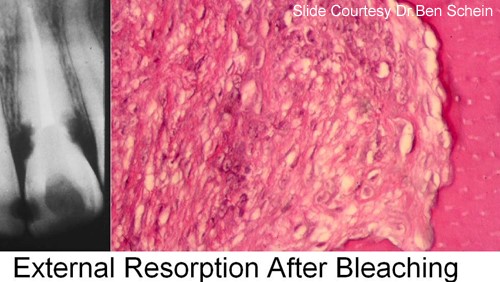Proper protection for non-vital bleach cases – A Case Study
The increase in the demand for cosmetic services has resulted in more bleaching treatments being performed by General Practitioners. In the case of the Endodontically treated tooth, internal bleaching techniques such as the Walking Bleach Technique are often used to improve the cosmetic appearance. Proper use of these caustic bleaching solutions can have real benefit. However, when used improperly and with inadequate protection of the root canal filling material, they can cause catastrophic external resorption.
I came upon an example recently. Discolored #21 (US #8) had a history of traumatic episode and 8 year successful NSRCT. The patient requested Cosmetic improvement. One year previously, the tooth had an internal bleach attempt (Superoxol) with no protection of the gutta percha filling. Percolation of the bleach into the unprotected dentinal tubules resulted in circumferential external resorption to the level of gutta percha. Periodontal findings indicated circumferential acute gingival inflammation and generalized loss of attachment to the level of the gutta percha. The prognosis was grim. Compounding the situation was the presence of virgin proximal teeth. I very much wished to avoid having the referring Dentist prepare these perfect proximal virgin teeth for a 3 unit fixed bridge. The patient had insurance benefits to the end only to the endo of the month. When I explained the situation and options, the patient became very upset, mostly because his insurance would NOT cover the cost of the omplant.
This scenario placed me (the Endodontist) in the precarious position of having to explain why the referral’s apparently successful 8-year-old endodontic treatment had suddenly become symptomatic after the tooth was bleached. The patient elected to extract and place a single tooth implant. Unfortunately, I lost a good referral because I was forced to truthfully explain to the patient what had happened.
All of this could have easily been avoided by:
(1) Avoiding the use of strong Peroxide solutions INSIDE the access of previously endodontically treated teeth. Adequate protection of the gutta percha and underlying dentin is required before application of the bleaching agent. Protection is best provided by the use of a well sealing glass ionomer or composite restoration of 3-4mm minimum thickness. This can be removed and replaced after the bleach, if necessary. You must also get FULLY informed consent (includeing ALL possibilities such as tooth loss) before proceeding with internal bleach.
(2) Dr. Ilan Rothstein’s papers have shown that Using Sodium Perborate alone ( without Superoxol – High concentration Hydrogen Peroxide ) can give equally good results without the resorption risk. The color change may be slower and it may require more applications over time, but results can be equally as good.
Summary
Clinicians performing internal bleach techniques must be aware of the potential adverse effects of these caustic agents. In the case of traumatized teeth, patients must always be informed of the potential risks of any treatment. Failure to provide adequate protection of the root canal filling material can lead to embarrassing loss of teeth with apparently successful endodontic treatment.

Figure 1: Chemical Injury and Resorption Caused by Internal Bleaching
The internal dentin was not protected prior to bleaching . The caustic solution leached into the PDL causing an external inflammatory resorption. Slide shows clastic cells resorbing the dentin.
